

Oil Palm - "Elaeis" (which means oil in Greek) is available in two species, one of which, Elaeis Guinensis, is available in the western and south-western Africa and in Southeast Asia, while the other, Elaeis Oleifera, is available in central and South America. Oil palm produces an edible fruit that resembles an apricot with a nut inside. Oil palms are used primarily for the production of palm oil.
Elaeis Guinensis is available in three different variants:
It is obvious that only Durá and Tenerá reveal palm kernel shells. It is almost exclusively Durá to be found in Africa, while it is almost exclusively Tenerá to be found on farms in Asia. This has to do with the fact that production in Africa is dominated by small and medium size family owned farms which have been around for generations, while Asien - especially Malaysia and Indonesien - is completely dominated by large industrial farms.
Mature palm trees are single-stemmed and grow up to 20 meters high. The leaves are pinnate and up to 3-5 meters long. The flowers are in dense clusters, each flower is small with three sepals and three petals.
Palm fruits are 5-6 months to mature from pollination to the ripe fruits. The palm fruit is reddish and about the size of a large plum and grows in large bunches. Each fruit is composed of an oily fleshy outer layer with one seed (core), which is also rich in oil. Once the fruit is ripe considering each class weights 23-27 kg for Durá and 40-50 kg for Tenerá.
The high oil yield of oil palm (as high as 7,250 liters per hectare annually for Tenerá) has made it a common ingredient in cooking in Southeast Asia and in the tropical belt of Africa. Its increasing use in the commercial food industry in other parts of the world is buoyed by its cheap pricing and the high oxidative stability of the refined product with high levels of natural antioxidants.
Palm shells is regarded as a natural high quality solid renewable fuel, either alone or with coal, possibly mixed with other types of biomass such as wood chips.
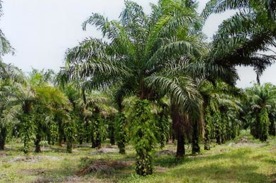
Plantation of oil palm trees. Oil Palm trees grow up to 20 feet high with 3-5 feet long leaves.
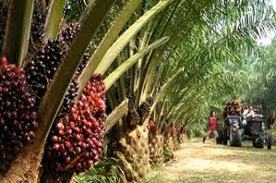
Fruit Bunches of oil palm trees. Each bunch weighting 23-50 kg when the fruits are ripe.
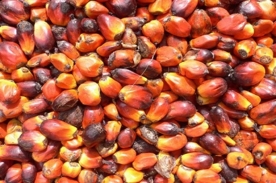
Fruits from oil palm. Oil palms produce an edible fruit that resembles an apricot with a nut inside.
Palm kernel shells are a waste product from the production of palm oil. The oil is extracted from both the pulp (palm oil, an edible oil) and the core (palm kernel oil which is used in the food and soap industry).
In the production of crude palm oil the flesh is steamed and cooked. Palm kernel oil is extracted from the fruit core as the core is crimped and oil is released. For every 100 kg of fruit bunches can typically extracted 22 kg palm oil and 1.6 kg palm kernel oil.
A waste product - the broken kernels - is the palm kernel shells and is a popular biofuel with high calorific value. For every 100 kg fruits around 4 kg palm kernel shells are left-over, ie. approx. 4%. Overall, palm kernel shells count for less than 1% of the total biomass in a palm oil plantation.
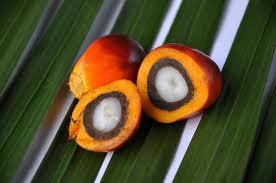
Over-cut fruit from oil palm. The three layers of which the hard shell middle layer is clearly visible.
| Parameter | Value |
|---|---|
| Moisture | 11-12% |
| Ash | 3.1% |
| Chlorine | 0.04% |
| Sulfur | 0.03% |
| Carbon | 46.5% |
| Hydrogen | 6.3% |
| Nitrogen | 0.36% |
| Gross Calorific Value | 5,200 kWh/MT - 18.80 GJ/MT |
| Net Calorific Value | 4,900 kWh/MT - 17.45 GJ/MT |
| Parameter | Value |
|---|---|
| Moisture | 0% |
| Ash | 3.5% |
| Chlorine | 0.04% |
| Sulfur | 0.03% |
| Carbon | 52.4% |
| Hydrogen | 5.7% |
| Nitrogen | 0.40% |
| Oxygen | 38% |
| Gross Calorific Value | 5,900 kWh/MT - 21.17 GJ/MT |
| Net Calorific Value | 5,500 kWh/MT - 19.93 GJ/MT |
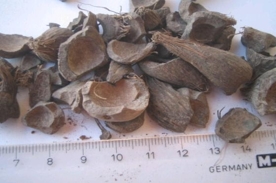
Palm Kernel Shells from oil palm. The shells are crushed under the extraction of palm kernel oil.
| Parameter | Value | |
|---|---|---|
| K2O | 6.62% | |
| CaO | 10.8% | |
| Fe2O3 | 3.98% | |
| MnO | 0.39% | |
| ZnO | 0.48% | |
| CuO | 0.091% | |
| BaO | 0.44% | |
| P2O5 | 3.5% | |
| SO3 | 0.9% | |
| SiO2 | 15.1% |